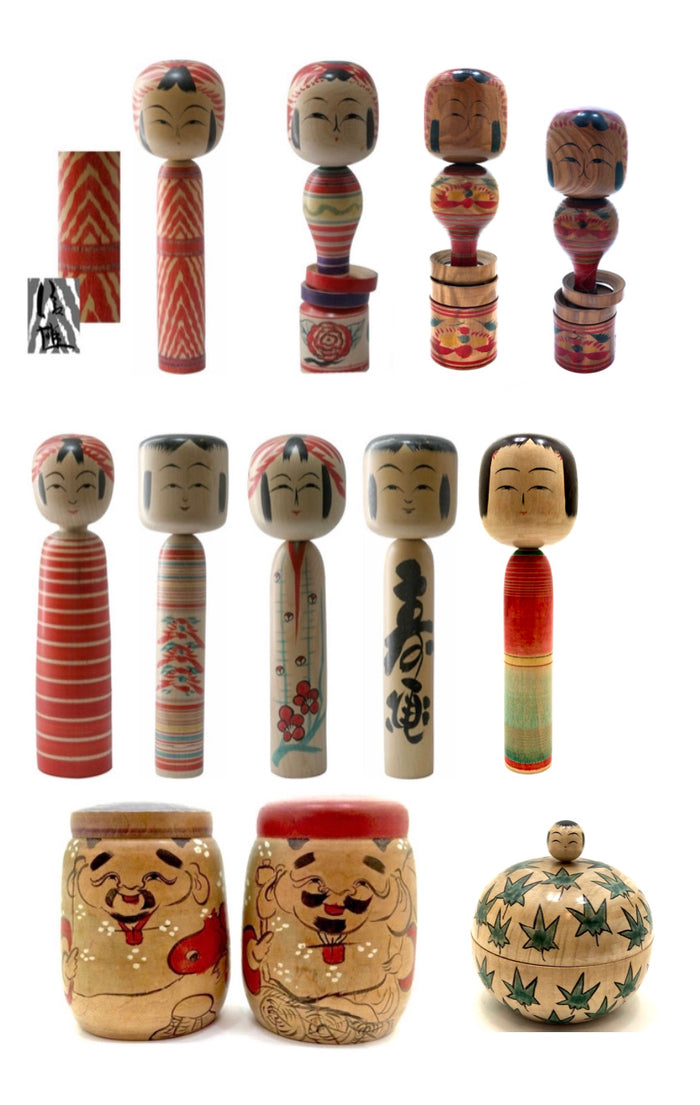

Vintage Japanese RARE Traditional Tougatta, Mokkumegane Style Kokeshi by Wagamatsu, Yoshio (1932-)
Dimensions: 14-1/4” h
Wagamatsu-san (b.1932-), is one of the Tougatta craftsmen who founded the Tougatta Kiji Union. This cooperative was able to gain the rights for reserved wood use from the Japanese Ministry of Forestry.
This Kokeshi doll was sold at the Akiu Onsen, Miyagi Prefecture, Sendai City, and is made in two parts. It is constructed by inserting a pin in the "neck" of the doll and then into the base of the head, (a squeeze-in type, which cannot be turned. As shown here, a pattern called, ‘Tegara’, in which the head is covered with a red chrysanthemum motif. It has radial curving lines moving from the top of the head down onto the forehead and covers the sides of the head. This doll exhibits the typical Tougatta bangs split in two with side hair fringes, thin narrow eyes, and a split-type nose. The doll has a narrow, columnar body shape, tapering at the shoulders to a head that is wider than the rest of the body and is more angular than round. It also incorporates the ‘Rokoru Moyo’ circular treatment to create an impression of the collar of the Kimono and the Obi. All done in variegated red pigment. The entire piece is finished with natural-colored candle wax, (Rosoku no ro).
As for the body decoration, it is a hand-painted abstract pattern referred to as ‘Mokumegane’, which has the addition of stripes. This was made to take on the appearance of the same natural wood grain. Most of this doll’s style shows the wood treatment on the body and was painted while it was still on the lathe. This wood treatment was developed as a family pattern, which at the time could only be used by an artisan who has attained full mastership in the Tougatta Kiji Union, which makes this particular type of Kokeshi VERY rare, particularly because of its large size. We placed it on the market for sale. Most dolls on the market measure 8-0” or smaller. Wagamatsu-san’s signature is on the bottom of the doll.
To read more about this Family of Kokeshi makers go to: https://mingeiarts.com/collections/tougatta-kei-family
Condition: Excellent, meaning that the piece retains its original craft/workmanship, showing a wonderfully developed patina commensurate which suggests a degree of wear that corresponds to its vintage. It is void of damage, cracks, breakage, or repairs. There is slight fading of the original colors which is commensurate with age and meets all the standards of the collectible Traditional Tougatta-ken Kokeshi.

Japanese Traditional Kokeshi
Tougatta-Kei (Family)
Prefecture: Miyagi
Origin:
Tougatta dolls are considered the oldest family members of the Traditional school. They originated in the Tougatta Onsen in the Miyagi Prefecture and were subsequently produced at Aone Onsen and the cities of Sendai and Izumi. In the 1960s, Togatta craftsmen founded the Tougatta Kiji Union, a cooperative that gained the rights for reserved wood use from the Japanese Ministry of Forestry. Collectors easily find the Tougatta style in an interesting range of variations.
Collector's note – characteristics/painting style:
Tougatta dolls are easily recognized by their narrow, columnar body shapes, tapering at the shoulders, to a head that is wider than the rest of the doll, and more angular than round. The head is a squeeze-in type, and it is covered with a painting of a chrysanthemum. Most Tougatta dolls have split bangs (Hachi), with side fringes, crescent-shaped double-lidded eyes (many of which have arched brows), and a split nose or cat-type nose. Several have paintings of chrysanthemums (Kiku), plums (Ume), and irises (Ayame), usually in very stylized designs. The dolls decorated with plum branches and blossoms are associated with Aone Onsen. There is also a group that has ‘banded’ bodies primarily in red with some green. These are decorated in a circular-style painting known as Rokoru Moyo, which is done as the doll is turned on the lathe. The most collectible type is the Tougatta Mokuma style, in which the body or kimono is intricately painted with a detailed and variable wood grain pattern.
NOTE: The rare Tougatta Yamiyo dolls are created with loose rings circling the waists. Carved from the same wood as the body- it is a very meticulous method! It is also seen on Yajirou and Tsuchiyu dolls, though just as rare.

Leading Craftsmen:
Agatsuma, Shozo, 1932- No additional published information
Saito, Ryosuke, 1925-2015 - No additional published information
Sato Fumio, 1923-1986. Lineage: Tougatta lineage Master: Sato Bunsuke Disciples: Sato Hidehiro / Kobayashi Sadao / Ohata Hideo. Born in Togatta-Shinchi as the eldest son of Sato Ushizo and Tamayo, woodworkers in Togatta-Shinchi. He trained in woodworking under Sato Bunsuke. In 1940 Sato-san learned how to turn kokeshi dolls and toys. Fumio was said to have both the Bunsuke and Ushizo characters inside him and was always caught in a conflict between his two mentors from the Tougatta and Hijiori families.
Sato, Bunkichi, 1922-2008 - No additional published information
Sato, Kouichi - No additional published information
Sato, Masairo, 1938- No additional published information
Sato, Nirio, 1948, (Tougatta, Miyagi) - Master: Sato, Teruo
Sato, Teruo, 1919 - (Tougatta) -Master: Sato Seisuke
Sato, Tomio - No additional published information
Sato, Yoshiaki, (Tougatta, Miyagi) - Master: Sato, Teruo
Sato, Ushizo , Master - (Tougatta, Miyagi Spa)
Nagao, Masayoshi, 1931-2001, (Sendai, Miyagi) - Master: Sato, Mamoru
Wagamatsu, Yoshio, 1932 (Aone, Miyagi) - Master: Wagatsuma, Kichisuke
Explore & Learn More about Tougatta-Kei (Family)